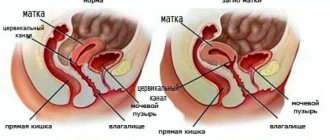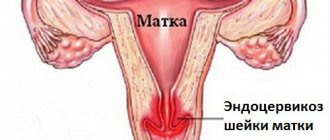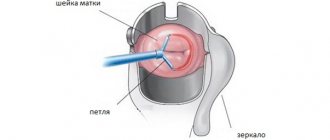Causes
Why does cervical erosion occur in nulliparous women? The common and most obvious cause of cervical ectropion is believed to be hormonal imbalance in women. Estrogens are mainly blamed for causing cervical erosion in nulliparous women. However, doctors are not limited to blaming only hormonal imbalances, but also give a number of other conditions that serve as the causes of cervical erosion in nulliparous women.
The causes of cervical erosion in nulliparous women also include microbial diseases, mainly transmitted through sexual contact, mechanical trauma and damage to the genital organs, the influence of chemicals and a number of other factors, which will be discussed below.
Hormonal imbalance
In particular, we will talk about fluctuations in estrogen levels during different periods of a woman’s life.
A woman's uterus is a hormone-dependent organ. Estrogen has several effects on this organ, but in the context of the problem under discussion, we will be interested in only two of them. First, the estrogenic effect ensures normal growth of the uterus and an increase in its size. Secondly, estrogens are directly responsible for the processes of epithelization of the cervix, which occur in the same cyclical manner as the processes in the endometrium, for which estrogens are also responsible.
Thus, fluctuations in the level of estrogen in a woman’s body, especially upward, lead to an increase in the size of the uterus, which leads to “eversion” of the cervical canal, activation of the processes of proliferation of epithelial cells of the cervical canal and the formation of cervical erosion.
Thus, one quarter of newborn girls experience congenital erosion of the cervix, the causes of which are hidden in the influence of mother’s estrogens on the fetus in utero and further after birth through breast milk. Congenital erosion of the cervix in nulliparous women, the causes are leveled out with age and spontaneous convalescence can be expected.
Teenage girls also belong to this category, since during puberty uneven jumps in the level of female hormones are very common due to the insufficient maturity of the reproductive system.
Women who use combined oral contraceptives as a method of contraception are also at risk for developing cervical erosion. This is due to the fact that oral contraceptives contain an estrogen component. The same applies to women taking hormone replacement therapy for one reason or another.
The dosage form of a drug containing an estrogenic component is not of fundamental importance. Whether it be pills, creams, patches or vaginal rings, they can all equally trigger the development of cervical erosion.
Obesity
Attributing this condition to the diagnosis of cervical erosion in a nulliparous girl as a cause may seem illogical, but once you think about it, everything becomes obvious. It has been proven that obesity is both a cause and a consequence of metabolic syndrome, which in turn entails significant changes in hormonal homeostasis in a woman’s body, including the balance of sex hormones. In addition, adipose tissue itself is a hormone-producing organ and it produces estrogen - the main culprit, according to doctors, of ectropion of the cervix.
Traumatic impact
Damage to the cervix, as well as irritation, can also contribute to the development of cervical erosion in some women. This is very common among women who use IUDs. If you use tampons that are inserted into the vagina, especially over a long period of time, you may also experience erosion of the vagina or cervix.
Sexual contacts using additional equipment, sex toys, especially rough and unconventional forms of sexual contacts lead to damage to the delicate epithelium of the vaginal part of the uterus and its ulceration.
Medical gynecological procedures affecting the cervix also place a woman at risk for the formation of erosion. Such procedures include all techniques that involve expansion of the cervical canal: hysteroscopy, fractional diagnostic curettage, abortion, insertion of intrauterine devices.
Chemical substances
Diagnosis of cervical erosion, the causes of its appearance in nulliparous women are also often caused by the ingress of various chemicals into the vagina. This happens when a woman resorts to using industrial or homemade chemicals for the purpose of contraception or hygiene. The most common cause of cervical erosion from chemical exposure is the use of various spermicidal foams, creams and suppositories for the purpose of contraception.
Symptoms
Symptoms of cervical erosion in nulliparous girls are usually mild and in most cases completely absent. However, if there is extensive damage to the cervix, the girl can pay attention to such signs of cervical erosion as symptoms in nulliparous women, such as:
- Copious vaginal discharge, non-inflammatory. This is due to the fact that columnar epithelium, replacing normal stratified epithelium, produces additional secretion.
When a secondary infection occurs, the nature of the discharge may change; it acquires a yellow-green tint and an unpleasant odor. This is a reason to contact a doctor.
- Contact bleeding. A woman may notice slight spotting after sexual intercourse, which is due to the more fragile structure of columnar epithelial cells. Typically, the amount of contact bleeding during erosion does not exceed a few drops. In case of large blood loss, you should immediately seek medical help to exclude other life-threatening conditions.
- pain during sexual intercourse (dyspareunia) and when examined with a speculum.
https://youtu.be/vuD4zQ6duNQ
Types of disease
True erosion, as a rule, occurs as a result of chronic inflammatory diseases and mechanical damage (sexual intercourse, childbirth, surgery). At the same time, experts identify several development options: ectropion (eversion of the mucous membrane of the cervical canal), cervical endometriosis, leukoplakia, polyps. The consequences of the development of cervical erosion are very variable.
The cause of ectopia is hormonal disorders. A characteristic feature of pseudo-erosion is the integrity of the mucous membrane. The main sign of the disease is a red ring around the opening of the cervical canal several centimeters in size. This condition does not require special treatment and goes away on its own by the age of 20.
You can find out the price of a cervical biopsy for erosion on our website https://www.dobrobut.com/. By filling out the form, you can make an appointment with a gynecologist and undergo the necessary examination.
Treatment
Cervical erosion is a condition that may not bother a woman at all and she is notified of its presence exclusively by an obstetrician-gynecologist during a routine annual examination. Therefore, many are wondering: is it necessary to treat cervical erosion for nulliparous women if it does not bother them.
Cervical erosion itself is not a disease, but only a feature of the morphological structure of the integumentary epithelium of the cervix. From this position and point of view, cervical erosion may not require treatment in nulliparous women and an obstetrician-gynecologist after a comprehensive examination (smears from the integumentary epithelium of the cervix for atypical cells, colposcopic examination of the vaginal part of the cervix, targeted biopsy of the area of ectropion of the cervix and test for the presence of highly oncogenic strains of the human papillomavirus) may be limited to prescribing only dynamic monitoring of the state of the epithelial cover of the cervix, if the existing erosion does not belong to a risk group for the development of cancer transformation.
In the event that the doctor has even the slightest suspicion of a malignant nature or a high risk of malignancy of the condition of cervical erosion in a nulliparous girl, treatment will be selected and prescribed immediately.
The basic principle of how to treat cervical erosion in nulliparous girls does not differ from how girls with a history of childbirth are treated, and it consists in removing the area of the integumentary epithelium that has undergone erosive deformation. The only difference here will be only in the options for destruction of cervical erosion, which are preferable for use in nulliparous women.
But before treating cervical erosion in nulliparous women, it is recommended to go through the preparatory stage, which consists of prescribing antimicrobial and anti-inflammatory therapy. This is necessary in order to minimize the risks of developing complications, such as the addition of a secondary infection, when the main treatment of cervical erosion is carried out in nulliparous girls.
For the purpose of antimicrobial and anti-inflammatory therapy, obstetricians-gynecologists, as a rule, prescribe a course of local therapy with vaginal suppositories or tablets, such as Betadine, Ginalgin, Terzhinan, Polizhinaks, etc. The course of local treatment takes from five to ten days. For large cervical erosions complicated by the presence of sexually transmitted infections or bacterial vaginosis, combination therapy with local and systemic antimicrobial drugs is advisable. For the purpose of systemic treatment of infectious pathology, it is advisable to prescribe broad-spectrum antibiotics, such as azithromycin, clindamycin, josamycin, amoxicillin and ceftriaxone.
After completing the course of antimicrobial treatment, they begin to remove the eroded epithelial cover. How cervical erosion is treated in nulliparous women at this stage depends on the type of erosion, its size and depth of damage.
Small cervical erosions respond well to treatment using chemical destruction. This is a cheap and accessible treatment method that has shown good effectiveness in eliminating erosive defects. Cauterization of cervical erosion using the drug Solkovagil does not require hospitalization and can be performed in an outpatient clinic on the day of treatment. The method is very simple and consists of treating the eroded integumentary epithelium of the cervix with a drug from a combination of acids. The acid, interacting with the epithelium, causes coagulation and death of its cells. After the destruction of atypical cells of cervical erosion during the healing process, they will be replaced by cells of normal multilayered squamous non-keratinizing epithelium. Immediately after the procedure, the woman can be free. The recovery period is approximately two to three weeks.
The use of chemical destruction as a method of destruction of cervical erosion does not lead to the development of bleeding, scar deformation or stenosis of the cervical canal, however, it may be contraindicated for large areas of erosion.
An alternative treatment for cervical erosion in nulliparous women that can be used is radio wave destruction. Using a high-tech device that generates high-frequency radio waves, the erosive defect of the epithelium is affected. Under the influence of radio waves, excess energy accumulates inside the epithelial cells, which provokes overheating and self-destruction of the tissue. Since the depth of action of radio waves can be selected manually by the doctor and due to the fact that the method is non-contact, the radio wave destruction procedure is considered the most minimally invasive and gentle. In recent years, it has become the method of choice for the treatment of erosions in nulliparous women.
What methods are used to treat erosion?
Treatment methods for cervical erosion
Modern medicine does not stand still today; girls and women who have never given birth are offered a number of procedures that can help solve problems.
So, how can you treat ectopia:
- Laser.
- Chemical means.
- Radio waves (non-contact coagulation).
All of the above methods are considered gentle; their use helps maintain the elasticity of the cervix and avoid tissue scarring.
Chemicals - this concept includes various drugs that selectively act on cylindrical (altered) epithelial cells without damaging healthy tissue. The list of these drugs can include: Vulnostimulin, Solkovagin, etc.
Laser therapy is a good method that allows you to eliminate cervical erosion using a laser beam. After the procedure, wounds on the surface of the tissue heal quickly, complications occur extremely rarely. This treatment allows you to achieve almost 100% results. For nulliparous women, CO2 and helium - neon laser are suitable.
Coagulation with a radio wave apparatus involves the use of a radio wave knife, which “cuts” tissue without physical impact. At the same time, blood vessels and capillaries are “sealed” in parallel, which minimizes the likelihood of bleeding. This happens due to overheating of the cells and evaporation of moisture from them.
Cauterization
Is it necessary to cauterize cervical erosion for nulliparous women? Indications for cauterization of cervical erosion in nulliparous women are moderate cervical dysplasia, condylomatosis, and areas of endometriosis on the cervix.
Cauterization of cervical erosion in nulliparous patients is a standard conservative treatment for patients with severe cervical epithelial dysplasia (CIN ΙΙ/ΙΙΙ) to prevent progression of erosion to invasive cancer. Conization is also an effective diagnostic tool for suspicious squamous and glandular dysplasias occurring on the cervix. The methods of therapeutic and diagnostic conization are identical. Conization can be performed using a scalpel, an electrosurgical snare, or a laser, and these methods have different advantages and disadvantages. Conization using an electrosurgical snare is widely used throughout the world due to its convenience, low blood loss, and low incidence of postoperative bleeding. Traditional monopolar electrosurgical knives exist in every operating room, even in low-resource settings, and manipulations are easily performed without special instruments.
The danger of treating erosion in women
How can cervical erosion be treated for nulliparous women and girls? This issue is considered controversial. In gynecological practice, various methods are used, but not all of them are safe for patients of reproductive age who do not have children.
What are the main risks associated with:
- There is a high probability of dense scars appearing on the surface of the epithelium.
- As a result of the treatment, the elasticity of the cervix may decrease.
Incorrect treatment can cause infertility. If the cervix completely or almost completely loses its elasticity, then the woman will not be able to bear or give birth to a child. Problems will arise even at the stage of conception. Only IVF will help resolve them.
There are a number of techniques that are not used in gynecology for patients who do not have children:
- electrocoagulation (cauterization of the epithelium with hot electrodes);
- cryodestruction (use of liquid nitrogen).
These methods are considered unsafe, since when they are carried out, there is a high probability of scarring on the surface of the cervix, which significantly reduces its elasticity. For this reason, preference is given to other, safer methods that will help correct the situation and avoid the development of complications.
Why is it dangerous?
Why is cervical erosion dangerous, in nulliparous women in particular? Erosion itself is not dangerous if changes such as dysplasia or inflammation are not detected. However, its presence indicates the existence of some pathology that caused it and can itself affect a woman’s reproductive health: human papillomavirus, urogenital infections (especially latent), hormonal imbalance and some others. In addition, if surgical treatment using destructive methods is required, strictures and scars may remain, preventing pregnancy, pregnancy and childbirth.
Symptomatic picture and causes of erosion
Cervical erosion does not always have pronounced symptoms. This is due to the extremely small area of the epithelium on which erosion occurs. In most cases, erosion is detected during a routine gynecological examination. Signs of the disease appear only in the case of a large area of damage to epithelial tissue by erosion.
Symptoms of the disease:
- A feeling of discomfort in the vagina that occurs during or after sex. The degree of pain may vary.
- Vaginal discharge with bloody streaks in the middle of the cycle.
- Excessive white discharge. In some cases, purulent contents come out of the vagina.
One of the main reasons for the development of cervical erosion is the entry of microorganisms into the mucous membrane. These changes are associated with inflammatory processes.
Other possible causes of erosion:
- Infectious diseases that are transmitted during unprotected sexual intercourse, in particular herpes, ureaplasmosis, chlamydia.
- Constant discharge that irritates the vaginal mucosa and provokes desquamation of the epithelium. Erosion caused by this factor is called true. May be accompanied by bloody discharge. True erosion is an extremely unpleasant disease that causes severe discomfort.
- Vaginal dysbiosis, in which healthy microflora is replaced by pathogenic organisms.
- Injuries to the mucous membrane, for example due to surgical termination of pregnancy.
- Use of chemical contraceptives.
- Failure in the hormonal system.
- Weakened immunity, which cannot prevent the penetration and development of pathogenic microorganisms on the mucous membranes of the reproductive system.
- Promiscuous sex life.
Sometimes erosion goes away on its own, especially in young women. Possible complications include numerous infectious diseases, for which erosive formations on the epithelium serve as a favorable platform - these are genital herpes, human papillomavirus, chlamydia. Without proper treatment, in the presence of constant bleeding of damaged epithelium, there is a risk of developing tumors.








